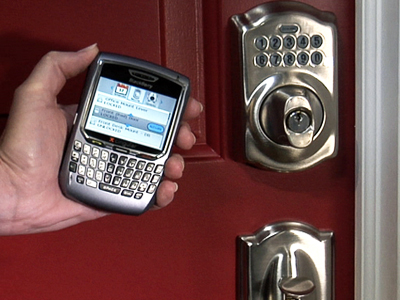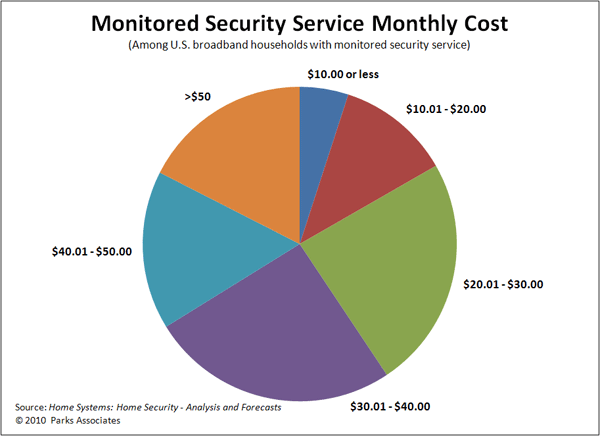PC-Based Home Security: Do It Yourself
We test products that let you monitor and protect your home without the need for an outside security company's services: D-Link, Axis, Logitech, Schlage

In Pursuit Of Better Security
A generation ago, many of us expected to be living in automated homes by now, perhaps with robots tending to our everyday, menial needs. Ten years ago, many still thought that by 2011 our homes would at least be marvels of networked security. So here we are. The need for physical home security sure hasn’t slackened, but how far has computing technology come in helping? We see movies in which action heroes must regularly circumvent elaborate biometric safeguards and all manner of computer-based protection. Do such things exist for everyday homes? If so, are they affordable and easy to set up?

Many people are content to call a traditional security company, get some sensors installed, plant a
This house protected by…” sign out front, and call it a day. However, according to Parks Associates, “the average monitoring fee for a U.S. household increased from $28.60 to $32 between 2008 and 2010.” The collapse of the housing market barely caused a hiccup in home security. As you can see from this pie graph, a decent-size chunk of subscribers pay more than $50, exceeding $600 per year out of pocket. Big security companies will point out that there’s a back-end benefit to monitoring in the form of lower home insurance rates. Of course, that’s not much incentive if you want more security for your apartment. Also, I’ve never had an insurance agent ask me anything beyond, “Do you have home security monitoring?” They’ve never asked me who the provider was, how many sensors or cameras were in place, or anything else. Just yes or no.

The downside with most conventional home security is that it hasn’t really changed from the 1980s. A well-executed smash-and-grab will be in and out in under two minutes, and that $30/month security system, complete with door, window, and motion sensors, will have saved you the trouble of dialing the police yourself.
“Ahh,” you say, “but now they have systems with video surveillance.” Very true. Of course, those systems cost a lot more. You can order a security surveillance kit from the likes of Swann or Lorex, but most of these still use CCTV cameras, and that means very long video cable runs, BNC connectors, and resolutions that top out at 450 lines, just like your old standard definition TVs. You probably also need a DVR and dedicated monitor to record and display all of the footage. This requires a remote control, DVR programming, and so on. Depending on the kit, you might be able to get alerts and remote viewing of your video streams, but this entails a higher-grade product which often costs more.
We prefer IP-based surveillance cameras for many reasons, including: 1) They use standard Ethernet cables or WiFi. 2) The range of functionality is often much broader than CCTV-bases products. 3) Resolution tends to be higher on IP cameras, which can yield clearer images. 4) The range of apps often available for IP cameras is much better than being locked into a single title from one security vendor.
In general, IP-based home security is easy, relatively cheap, and so much more flexible than conventional security. Devices plug into the network rather than any given PC, and you can often interact with them from anywhere across the Internet. We set out to get a sense for the kinds of products available in today’s IP-based home security market and how hard or easy they might be for the average person to set up.
Sign up to get the BEST of Tom's Guide direct to your inbox.
Get instant access to breaking news, the hottest reviews, great deals and helpful tips.
Current page: PC-Based Home Security: Do It Yourself
Next Page D-Link DCS-1130 Wireless N Network CameraWilliam Van Winkle is a freelance editor and tech journalist who has been writing for more than 20 years. His work has appeared on Tom's Guide, Tom's Hardware, Tom's IT Pro, AMD, Seagate, Computer Shopper, and more. He is also an author, writing poetry, short stories, and science fiction and fantasy books.
-
thegreathuntingdolphin William,Reply
Cool article. I have been looking into security cameras for the home, especially ones that are outdoor or pointed outdoor (some noobcakes have been hitting cars and driving off in my apartment complex). I am a bit dissapointed that most of these don't really seem good for outdoors or for long distance night recording (I know some of these said up to 20 to 30 feet but in my experience that means they are really only clear at 10-15 feet). Foscam has a number of cheap IP cameras with pan and tilt, are for outdoor use or longer night vision use. Do you have any experience with them?
The Schlage system is looking good. Hopefully others will jump on the bandwagon and get more products out. I am glad the Schlage deadbolt is not motorized like the Kwikset one since it greatly improves the battery life. Whenever I get a house I am definitly going to do something like the LiNK system.
I too am disappointed in the current IP-based offerings. The perfect IP-based camera seems illusive. Too many have half the features. Most the N wireless ones seems to lack really good night vision capabilities and the ones with good night vision capabilities usually are G only or have N are stupidly expensive. -
Nice article!Reply
It’s interesting how IP cameras and emerging technology, such as Jabbakam.com enable average people to transform a home surveillance system into a shared camera network that can be accessed by whoever is invited by the camera owners, to view the footage via an online account accessible from anywhere at anytime.
Jabbakam is a system where you have complete access to your footage, to manage and share as you want. You can easily create a network (public or private) and invite your friends or neighbours to join and add their cameras so that you all have access to the footage of the cameras as a group.
You can set up alerts so that you will be notified by email or sms if your camera detects something happening in front of it, and you have peace of mind that your camera is doing its job and working, thanks to a monitoring system that checks your camera status every few minutes. The Jabbakam website offers users a lot more functionality besides. Check us out, and join us on Facebook.com/jabbakam and Twitter (@jabbakam). We’d love to hear from you! -
It is still an annual subscription of $80 a year it is only very well hidden by Logitech (just try and buy it and you will figure it out).Reply
The hiding of subscription cost itself is terrible, but also that they sell you just part of a product is outragous. It makes me mad and takes some of the joy of owning such a cool (and expensive) product. -
I'll never buy a product that requires a subscription or is dependent on another site or "the cloud". Excellent article, except for the WPS thing.. WTH is that?Reply
